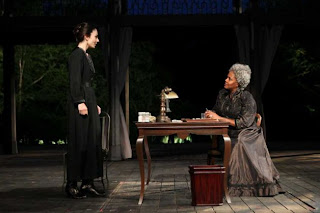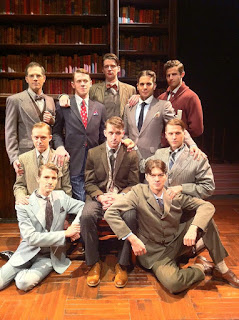
This summer in Central Park the Public Theatre is tackling two of Shakespeare’s “problem” plays. The first to open, All’s Well That Ends Well,” is officially one of the comedies, but although there are laughs and mix-ups between lovers the happy ending of this play has always been debatable. Directed with an eye on this problem, Daniel Sullivan does his best to make sense of the ludicrous plot and turns out a very handsome production whether he solves the problems or not. It certainly helps to have an excellent cast headed by the dignified Annie Parisse as Helena, Tonya Pinkins as the Countess and John Cullum as the King to make the mayhem believable. André Holland is sturdy as Count Bertram, but cannot invoke the sympathy necessary to make the ending believably happy. The play may be more at fault, but just the right personality in the role could assuredly help matters considerably for it is too easy to mark Bertram as a cad and leave it at that.
Because of the class system, Helena has no hope of attracting nobleman Count Bertram. However, after cleverly applying her father’s healing arts, she cures the King of France from fistula. As a thank you gift the King offers Helena her choice of husband from a number of men of the court. She picks Bertram, but he is not enthused. When Bertram skips out on Helena to go to war without consummating the marriage, the plot kicks into gear as Helena sets out to win her husband back. Ridiculous plot points ensue until in the end, “all’s well that ends well.” Through trickery Bertram is forced to marry Helena and although this is her wish, it is made crystal clear that it is not his wish. Yet, the final dialogue illogically makes us understand that this “comedy” has a proper happy ending––the couple is finally brought together. To a modern audience it is a great suspension of disbelief to accept the forced marriage as a happy one.
Sullivan attempts to solve this problem by allowing Bertram to find a kind of happy surprise in his feelings upon his one and only kiss with Helena before running off to war. This glimmer that some special thing connects the pair is the one and only link to the notion that the marriage is meant to be despite his philandering. This careful touch helped a lot, but the rest of the proceedings are too ridiculous to completely support it. However, put the obvious problems of the text aside and there is a handsome, entertaining production, coupled with the always enjoyable outdoor setting of the Delacorte Theater. The production is well worth the arduous wait in line to pick up those free tickets.









